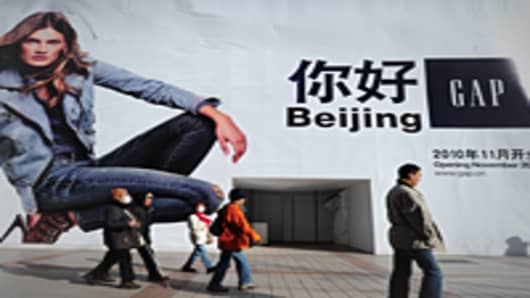Some multinationals already have a huge presence in China, like McDonald’s, Coca-Cola and Procter & Gamble. But American retailers are just beginning their push into this country as consumption is on the rise and an investment boom is resulting in scores of new upscale malls and shopping districts.
“The timing is right,” John Ermatinger, Gap’s president for the Asia-Pacific region, said Wednesday, while touring the flagship store here as workers folded shirts and spruced up the interior. “We’ve declared that 12 percent to 25 percent of our revenue will come from the international market by 2013. And I think we can do that.”
Chinese consumers are legendary for their saving habits. But analysts say China’s consumer market is likely to storm ahead in the next decade, and pass the United States. Retail sales grew by about 15 percent in China last year.
The streets of Shanghai and Beijing look increasingly like New York City, Chicago or San Francisco, with Louis Vuitton, Gucci, Nike, Starbucks and Apple all seeking to entice shoppers. A report released in January by Credit Suisse predicted that by 2020 China would account for nearly a quarter of the world’s private consumption.
“It is likely to provide a badly needed source of spending for the rest of the world,” the report said.
The Chinese government is backing the spending spree, trying to raise salaries and encourage more consumption as part of its long-term plan to restructure the economy and create more balanced and sustainable growth.
Global brands are hoping to profit from the shift. In the 1990s, Western corporations came to set up factories, and also contracted with local manufacturers to have products made here. Long before setting up its retail operations here, Gap had much of its clothing manufactured in China.
Now Gap and other retailers want to market to China’s nouveau riche and the emerging middle class. With its first store, a bright and sleek 12,000-square-foot outlet in the city’s upscale Hong Kong Plaza area, Gap hopes to promote its classic 1969 jeans, winter clothing and also its baby and Gap Kids clothing lines.
“We’re talking to a lot of companies that are saying, ‘I’m ready. How do I come?’ ” said Max Magni, head of the consumer practice for greater China at McKinsey & Company, the consulting firm.
But retailing experts warn it will not be easy. The country’s consumer market is still in the early stages of development, with consumption in smaller cities lagging far behind larger ones.
National distribution is complex; marketing and television advertising is largely local; pricing is fiercely competitive; and counterfeiting is widespread, the analysts said.
Wal-Mart has 189 stores in China and reported sales of about $7.5 billion last year, according to Euromonitor International, a market research firm. But of America’s 100 biggest retailers by revenue, only about a dozen operate independent stores in China.
Business experts cite the challenges and high cost of doing business in China. Mr. Magni at McKinsey said that initially many brands entered China through department stores, which they considered less costly and therefore less risky.
Until several years ago, there were government restrictions on foreign companies operating retail outlets, but even when those disappeared, retailers still worried about how to make sense of a complex marketplace and how to appeal to local tastes.
“Some brands entered late because with clothes, you need to follow the trends and styles,” said Chen Yuxin, a professor of marketing at the Kellogg School of Management at Northwestern University. “But now, this is changing. People want to be fashionable. And they like foreign brands.”
Many global retailers are scrambling to find good locations in China’s biggest cities. European retailers like Carrefour, Tesco and Metro A.G. are opening big supermarkets. Luxury brands say that in the next few years China should overtake Japan as the world’s biggest market for luxury goods.
And midrange apparel retailers like H&M, Zara and Uniqlo of Japan have gotten off to a strong start with new outlets in Shanghai — sometimes with long waiting lines just to enter the stores.
After a lengthy study, Gap is starting off with four stores, an e-commerce site and a China advertising campaign that features photographs taken by Annie Leibovitz. Gap executives say they hope to build on the success the company had with over 100 stores it operates in Japan. They would not disclose the cost of the new China venture.
Gap will market goods ranging from children to adults, while placing most of its emphasis on consumers in their mid- to late 20s. Prices in the China stores are expected to be comparable to those in the United States, meaning Gap’s initial strategy does not seem aimed at charging premiums. Still, in a country with a per capita income that is far below that in the United States, Gap will be a premium brand here.
Gap Inc., based in San Francisco, is coming off a tough 2009, when the company’s global revenues declined. This year, the company’s American growth has been anemic. But like most global retailers in China, the company says it is “extremely bullish” on its prospects here.
“We believe the best is yet to come in China,” said Mr. Ermatinger, the Gap executive.


